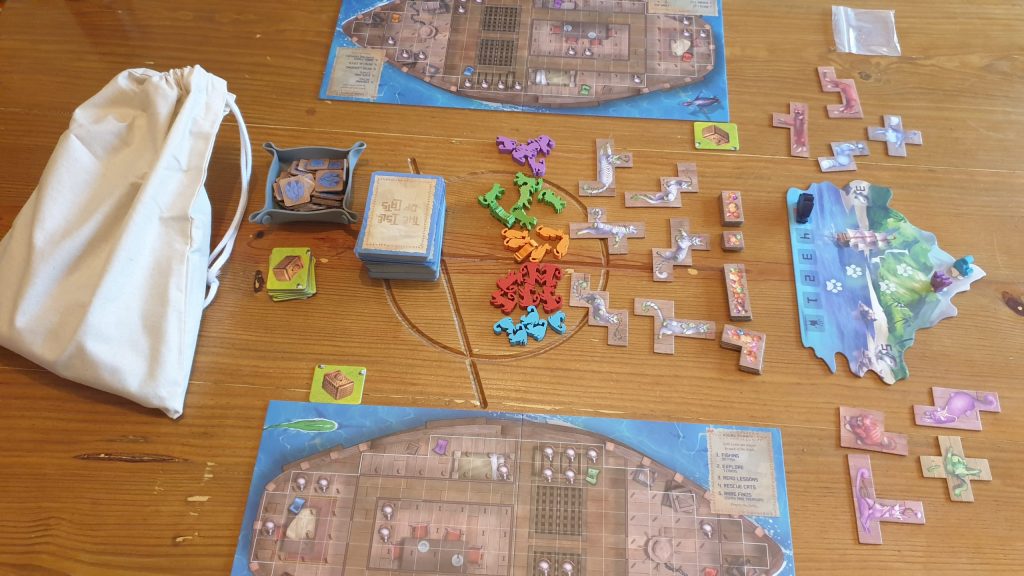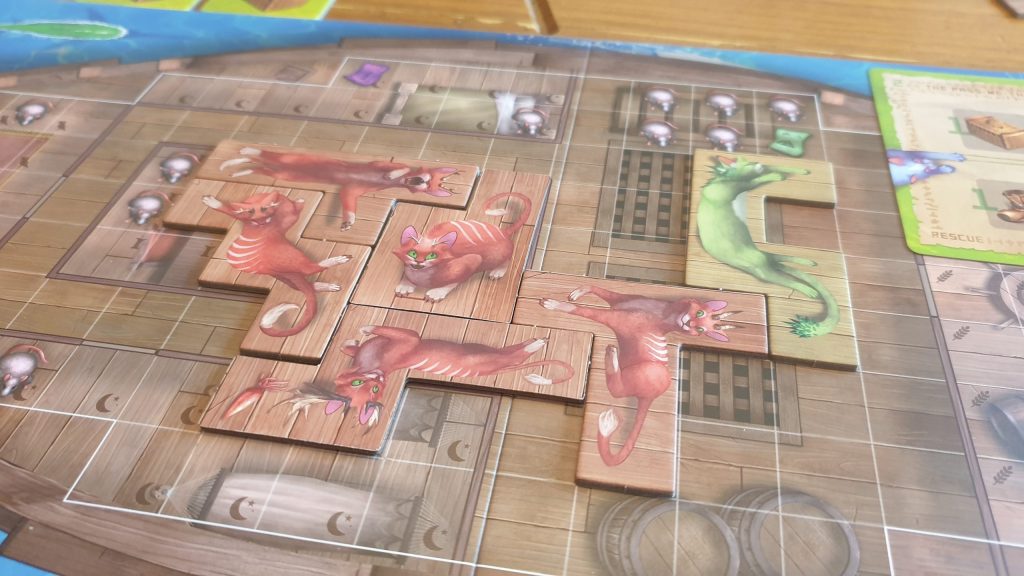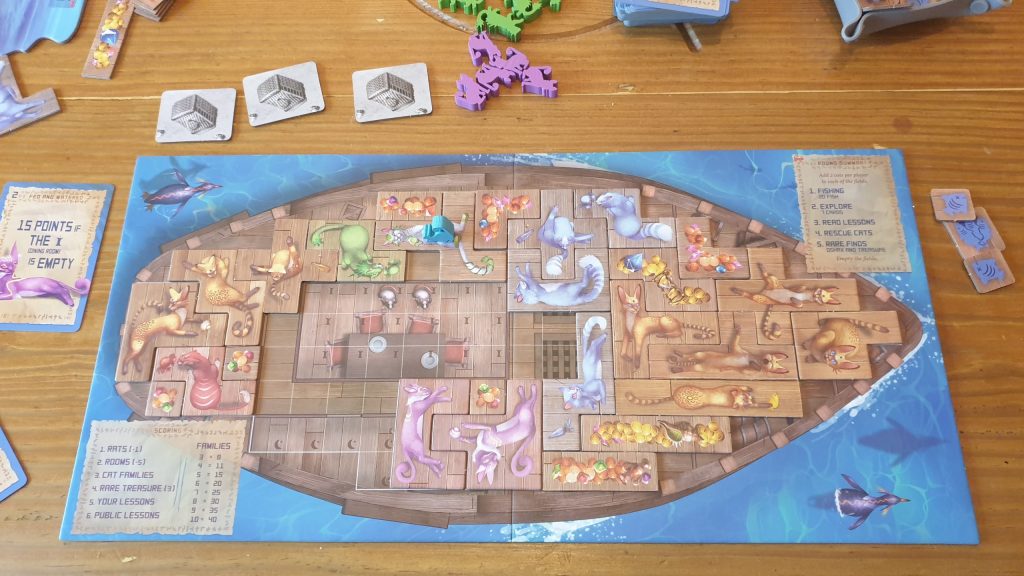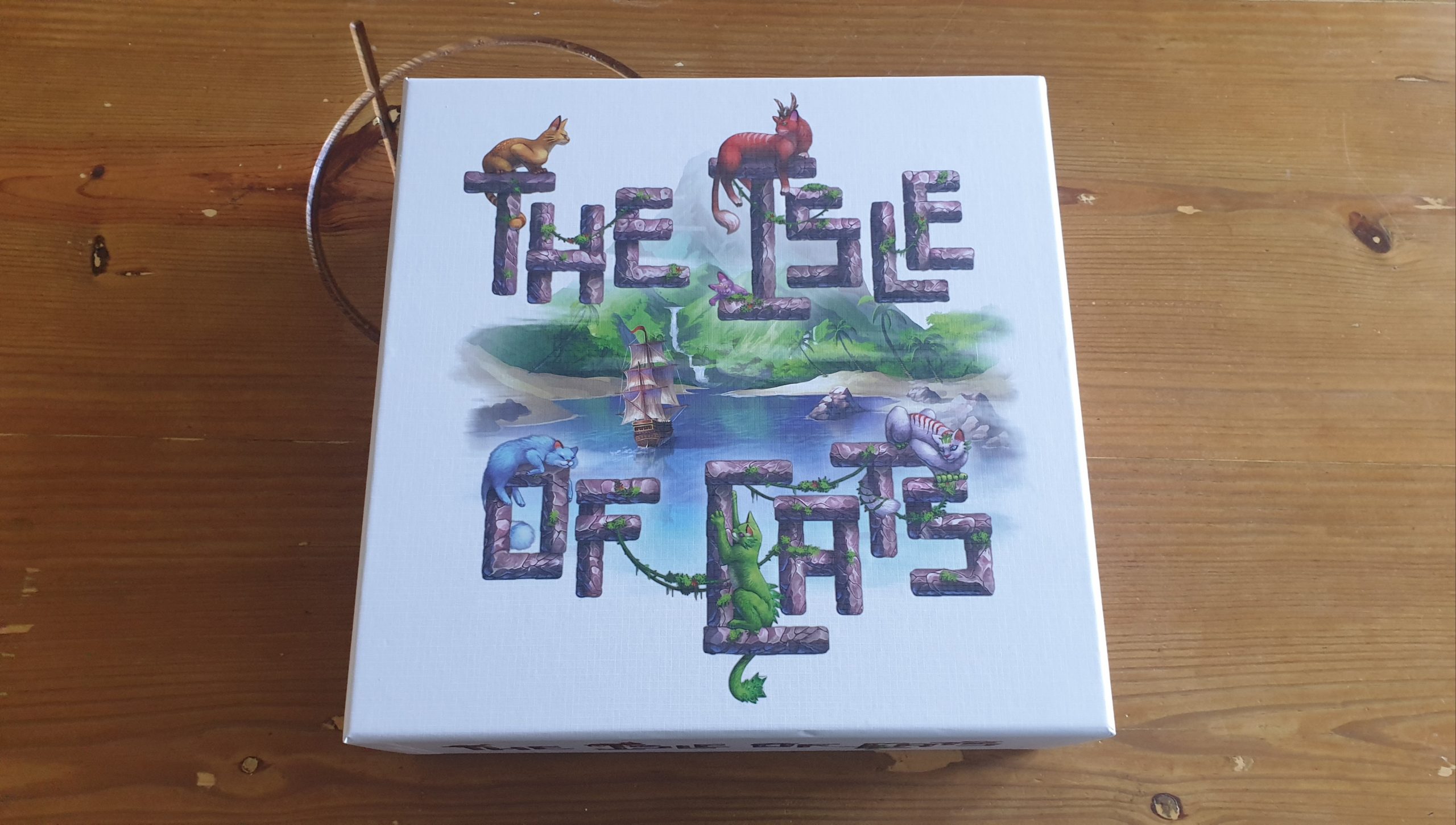The Isle of Cats is a strategy board game from publisher The City of Games, that features card drafting, tile placement and plenty of cats! Designed by Frank West, the game sees 1 – 4 players set out to rescue cats before their home is destroyed. By drafting baskets, luring cats with fish and squeezing them onto their ship, players aim to save as many as possible, whilst fulfilling lesson cards. Taking around an hour to play the game also comes with a family variant. However, will players want to save the cats or save themselves from the experience? Let’s find out!
Setup takes a tad longer before the initial play, though this is mostly to correctly put most of the cat tiles and common treasure tiles into the large discovery bag. Past this, everyone needs to grab a player board and the island board that tracks the rounds and player order is put in the middle. Players then put a coloured cat meeple on the order tracker and the rest of the components are put within reach.
The Isle of Cats is played out over 5 rounds, each with 5 phases. This includes some smaller steps and cleanup, so it isn’t all taxing. After filling the two fields (either side of the island board) with cats, from the discovery bag, it is time for fishing. Being one of the smaller steps each player gains an income of 20 fish – to spend later in the round. Next up it is time to explore, which is a card drafting stage followed by choosing what to keep. Each player is dealt 7 cards. Each player chooses two cards from the seven before passing the rest on to the next player. From the 5 cards they are passed they pick another two and so on until everyone has chosen 7 cards. Each card comes with a cost of fish, with players choosing what to keep from their drafted 7 cards – paying the denoted costs.
At this point, if a player has any public or personal lesson cards they must be played. Lessons are effectively objective cards that can award players points. For some public objective cards the person playing them may have a choice to make, for example the colour cat it refers to, though all players will still score the card at the end of the game. After this, in turn order, players decide which rescue cat cards to play. These are played face down until everyone has played cards, at which point they are revealed. Rescue cat cards show boots and/or baskets. Each player totals their boots with the player order adjusted based on whoever has the most.

Baskets come in three types: permanent, regular and broken. Permanent baskets can be used once each round, regulars are one time use and two broken baskets combine to act as a regular basket. These are needed to rescue cats. Going around the table, based on turn order, each player can spend fish and a basket to rescue a cat. Cats mostly come from the two filled fields, with the left field having 3 valued cats and the right offering 5 valued cats. Rescued cats are instantly added to a player’s personal board. Players will lose points for rats and rooms they leave uncovered by cats and treasures, so there is quite the incentive to rescue cats!
The final stage of a round before cleanup is rare finds. In this phase any special Oshax cats and rare treasure cards can be played. These tiles are added instantly to player’s ship boards, with a coloured cat meeple added to Oshax cats to indicate which colour cat they will represent when scoring. Once this is done the unrescued cats in the fields are returned to the box. Conversely, any unspent fish, unplayed cards and rare treasure tiles carry over to the next round. If 5 rounds haven’t been played then it is onto the next round, otherwise it is time to score. Players will gain points for groups of coloured cats, for lessons both private and public and rare treasures. Players will then lose points for rats and unfilled rooms on their ship. The player with the most points wins, with ties split by remaining fish tokens.
The standard mode is how most gamers will want to play, utilizing card drafting to ramp up the strategy side of the game. There is however a family mode, which allows the game to have the 8+ year old recommendation on the side of the box. Whether you’re wanting a more chilled playthrough or want to teach the game to new players, this is still a strong experience. Family mode makes the central puzzle of tile placement the sole focus. The main deck is replaced with Family Lessons, with each player choosing two from three at the offset of the game. No other cards or baskets are used, instead players just draft the cat tiles from the middle – skipping the complexity of the standard cat rescuing. This should allow players to get the game to the table easier, especially with younger players.
If you’re looking for a game that is just about gaining Tetris shaped tiles and adding them to a board, then the standard The Isle of Cats experience may be a bit slow for you. It is the most important part of the gameplay but it is far from the only thing. There’s the drafting, plus calculating the number of fish you can afford to use. Therefore, there are gaps between the tile placement phases that last as long, if not longer, than the tile placement phase itself. All of these elements overlap and must be taken into account to score big. While making it a great puzzle, those looking for a pure tile placement game may find too much – which is where the family mode comes in.

It is very likely that players will get to see a lot of the cards in one game. With 2 players within the first game alone we had cycled through half of the deck, so there isn’t a huge amount of variety from game to game of what could come up. Instead, there is a learning element to The Isle of Cats, making it a game that can grow with you. Akin in some way to Terraforming Mars, players will start to know what could come up and work that information into strategies. There is always the hidden information of what personal lessons other players have taken, though you may still have seen them as part of the drafting process.
There are a lot of phases to each round, with some having multiple steps. Thankfully, when players get into the flow of things, which is often during their first playthrough, many of the steps are easy to breeze through. The only phases that slow the game down are those that offer players plenty of choice, be it the drafting, the cat rescuing or the placement phase. With a two waved choice like this, combined with player potentially being able to remember what opponents may have drafted, there is an opportunity for analysis paralysis to creep in. Even with only 2 players the turn order matters for choosing rare treasures or cats. Both can impact how well you score lessons, then there’s how to fit them on your board to decide on. This is all before attempting to work out what opponents may want. Players that want to ponder about every decision may drag the speed of the game down to a snail’s pace, or perhaps a cat’s nap.
As much as the cats make for a lovely theme it is also rather pasted on. At no point while playing do you feel like you are rescuing cats from an island. During the game it is firmly a polyomino puzzle to solve. It’s only when you stop to look at the bigger picture that the cuteness seeps in, otherwise players will be looking at the pieces as things to squeeze into gaps rather than cats to get on a boat. This isn’t helped by the way cats and treasure tiles can be placed in a way that they seemingly sit through the walls of the rooms.

It is impossible to deny that The Isle of Cats is an eye catching game though. The personal player board boats have some great details on them, with a vivid blue ocean below them. The colourful cats, in a variety of sprawled out poses, add further vibrancy. The cards are on good card stock and their design allows the information to be easily understood. All of the main components aside, the discovery bag, that the cat tiles are pulled from, is the largest and thickest bag I’ve seen included with a board game, and is somehow with all of the great components the standout piece.
Going into The Isle of Cats I was certainly on the hype train, not for the cat theme (as many were) but the combination of mechanisms. Hype trains have the unfortunate effect of putting pressure on a game and this one did not succumb, nor has it let players down. The way that players need to make decisions between drafting cards alone is an interesting one, choosing between point scoring lessons and cards that may help rescue the cats that score points. On top of this, players have to balance spending fish for cards and the cats themselves. All of this is done before the puzzle of polyominoes, with plenty of fun to be had trying to squeeze cats onto your boat. With so many choices to make, The Isle of Cats won’t be for everyone – for some it might be too many choices and a slog as a result. For the rest of us, The Isle of Cats is a glorious looking game that doesn’t disappoint gameplay wise!
(Editor’s Note: The Isle of Cats was provided to us by Asmodee for the review. The game is currently available from local board game stores! Find your local store here.)

